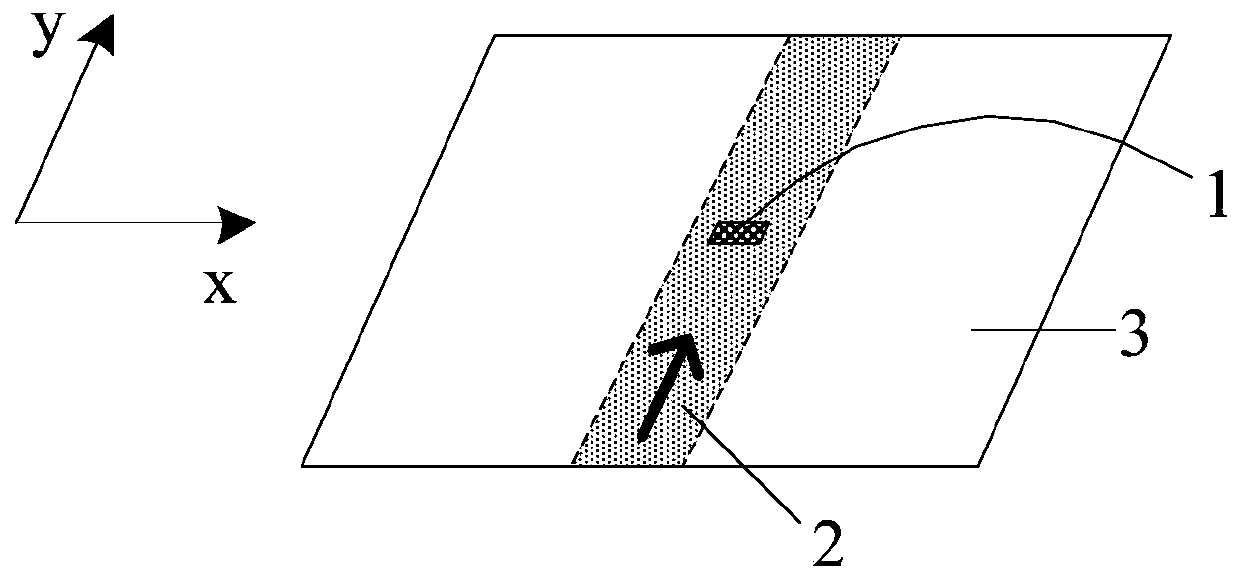PCB-based current detection device
A current detection device, PCB board technology, applied in the direction of measuring devices, measuring current/voltage, measuring electrical variables, etc., can solve the problem of weak ability to resist external magnetic field interference, and achieve strong anti-external magnetic field interference and strong ability Effect
- Summary
- Abstract
- Description
- Claims
- Application Information
AI Technical Summary
Problems solved by technology
Method used
Image
Examples
Embodiment 1
[0037] An embodiment of the present invention provides a PCB-based current detection device, Figure 2A shows its side view, Figure 2B A schematic diagram of its overall structure is shown, Figure 2C shows its top view, where, Figure 2A The "×" in the wire 20 indicates the direction of the current flowing in the wire (that is, from one side of the paper or screen where the reader is located to the other side), Figure 2B and Figure 2C The arrow inside the middle wire 20 and Figure 2A Corresponding to the "×" in the wire, it is also used to indicate the direction of the current flowing in the wire. The device comprises a first magnetoresistance 11, a second magnetoresistance 12, a wire 20, a PCB body 30 and a signal processing module ( Figure 2A , Figure 2B and Figure 2C not shown).
[0038] The wire 20 is printed on the first surface of the PCB body 30 for passing the current to be measured. Both the first magnetic resistor 11 and the second magnetic resistor ...
Embodiment 2
[0050] The embodiment of the present invention provides another PCB-based current detection device, Figure 5A shows its side view, Figure 5B A schematic diagram of its overall structure is shown, Figure 5C Its top view is shown. control Figure 2A to Figure 2C It can be seen that the difference between the device provided by the embodiment of the present invention and the first embodiment is that the device includes four magnetoresistances, that is, the first magnetoresistance 11, the second magnetoresistance 12, the third magnetoresistance 13 and the fourth magnetoresistance resistor 14 instead of two magnetoresistors. The specific arrangement of the four magnetoresistances in this embodiment will be described in detail below.
[0051] Such as Figure 5A As shown, the wire 20 used to pass the current to be measured is printed on the first surface of the PCB body 30, and the first magnetoresistance 11, the second magnetoresistance 12, the third magnetoresistance 13, an...
Embodiment 3
[0059] The embodiment of the present invention provides another PCB-based current detection device, the only difference between it and the second embodiment is that the magnetic sensitivity directions of the four magnetoresistors are the same.
[0060] Such as Figure 6 As shown, the first branch where the first magnetoresistance 11 and the second magnetoresistance 12 are located can be regarded as image 3 In the circuit shown, the second branch where the third magnetoresistance 13 and the fourth magnetoresistance 14 are located can also be regarded as image 3 circuit shown. Because the magnetic induction at the position of the first magnetic resistance 11 is greater than the magnetic induction at the position of the second magnetic resistance 12, the magnetic induction at the position of the fourth magnetic resistance 14 is greater than the magnetic induction at the position of the third magnetic resistance 13, and also That is, when placed in a magnetic field environment...
PUM
 Login to View More
Login to View More Abstract
Description
Claims
Application Information
 Login to View More
Login to View More - R&D
- Intellectual Property
- Life Sciences
- Materials
- Tech Scout
- Unparalleled Data Quality
- Higher Quality Content
- 60% Fewer Hallucinations
Browse by: Latest US Patents, China's latest patents, Technical Efficacy Thesaurus, Application Domain, Technology Topic, Popular Technical Reports.
© 2025 PatSnap. All rights reserved.Legal|Privacy policy|Modern Slavery Act Transparency Statement|Sitemap|About US| Contact US: help@patsnap.com



